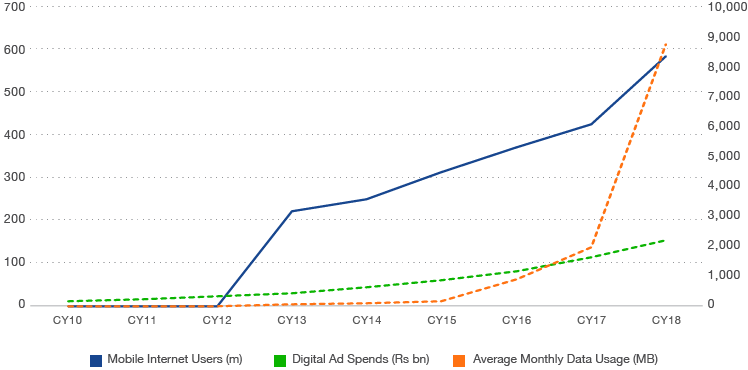By Jan van Eck, CEO for VanEck Global
Before we review financial market conditions, let’s focus on what we view as a big, investable trend.
The supernovas of the last decade are the digital platforms and one more opportunity is quietly being seized. Amazon has approximately 40% of the ecommerce market in the U.S.1 Alibaba has approximately 60% of the market in China.2 We think the next supernova may be mobile phone vendor Reliance Jio in India. Reliance Jio has more than 355 million mobile phone clients as of the end of October, with a target of 450 million by 2021, out of India’s approximately 1.2 billion mobile users.3 Are you sufficiently investing in this trend?
Digitizing India: Cellular Users and Data Consumption

Source: Bloomberg, Macquarie. Data as of 12/31/18.
Monthly data usage in India has actually surpassed China. In our view, there is disruptive potential that may create opportunities for investors as companies in India build out ecosystems to support India’s digitization. This may not be getting many news headlines, but I think it is very interesting from a growth perspective and an investable trend worth consideration.
Explosion of Digital Data Usage in India—What Are They Watching?!

Source: Bloomberg, Macquarie. Data as of 12/31/18.
Central Banks Still Drive the Market
In developed markets, we expect continuing slow to moderate economic growth as central banks ease and support economies. Heading into 2019, one of our key messages was “Don’t fight the PBOC (People’s Bank of China).” China was addressing its debt bubble in a very balanced and attentive way, and as we predicted, this drip stimulus approach has been effective. China’s economy continues to move forward, even though its manufacturing sector may be having trouble. I believe Chinese policies will be adequate support for global growth. See our regular updates on China’s economic growth for more insights.
Manufacturing PMIs: Emerging Markets vs. Developed Markets

Source: Bloomberg. Data as of October 31, 2019. Past performance is no guarantee of future results. Chart is for illustrative purposes only.
Although unlikely while managing a debt bubble, if China experiences a growth surprise, I think we would see global financial markets and commodity markets jumping higher.
On the other hand, financial markets may turn negative if the U.S. Federal Reserve were to suddenly turn hawkish, though I think this is doubtful in an election year. I believe another potential downside depends on whether central banks in Europe are still considered a credible counterweight to slower growth. As discussed in my previous outlook, Time to Hedge Against Central Bank Uncertainty?, I think investors should consider a hedge in their portfolio, such as a gold position, in the event that central bank confidence weakens dramatically.
Managing Volatility in 2020
Given the upcoming U.S. presidential elections and high valuations in equities, investors may be concerned about volatility and become cautious. However, I think valuation can be a misleading indicator of how financial markets behave in the short term. In our view, smart beta ETFs offer one way to help manage volatility. For example, the VanEck Vectors Morningstar Wide Moat ETF (MOAT®) and VanEck Vectors Morningstar Durable Dividend ETF (DURA®) incorporate an assessment of the valuations of individual stocks, and overpriced components are removed from the respective underlying indices at their quarterly rebalancing. In dealing with volatility, our view is that, rather than being overly cautious at the portfolio construction level, investors should evaluate the individual strategies in their portfolio.
Asset Management Industry Outlook
Similar to what we have seen among custodian banks and online broker dealers, the asset management sector has become more concentrated, creating scale that is driving price competition. Our key takeaway from this is that each company has to have a unique selling proposition distinct from scale or price. Part of the core philosophy at VanEck is to come up with interesting investment strategies that are thoughtful and appropriate to the asset class and meet investor needs.
Looking at financial advisors, I think they have to think beyond portfolio construction. While portfolios are important, many financial advisors are looking at other value-added services—such as tax-related advice, estate planning, healthcare and other types of advice—in order to differentiate themselves.
Happy holidays and happy investing in 2020!
DISCLOSURES
[1] Source: eMarketer. U.S. Ecommerce 2019. Data as of 5/31/19.
[2] Source: eMarketer. China Ecommerce 2019. Data as of 5/31/19.
[3] Source: Reliance Jio. Data as of 10/31/2019.
The information herein represents the opinion of the author(s), but not necessarily those of VanEck, and these opinions may change at any time and from time to time. Certain statements contained herein may constitute projections, forecasts and other forward looking statements, which do not reflect actual results, are valid as of the date of this communication and subject to change without notice. Information provided by third party sources are believed to be reliable and have not been independently verified for accuracy or completeness and cannot be guaranteed. Historical performance is not indicative of future results. Current data may differ from data quoted. Diversification does not assure a profit or protect against a loss. This is not an offer to buy or sell, or a solicitation of any offer to buy or sell any of the securities mentioned herein.
An investment in the VanEck Vectors Morningstar Wide Moat ETF (MOAT®) and the VanEck Vectors Morningstar Durable Dividend ETF (DURA) may be subject to risks which include, among others, investing in equity securities, health care, consumer staples and information technology sectors, medium-capitalization companies, market, operational, index tracking, authorized participant concentration, no guarantee of active trading market, trading issues, passive management, fund shares trading, premium/discount risk and liquidity of fund shares, non-diversified, and concentration risks, which may make these investments volatile in price or difficult to trade. Medium-capitalization companies may be subject to elevated risks. Please see the prospectus of each Fund for more complete information regarding each Fund’s specific risks.
Fund shares are not individually redeemable and will be issued and redeemed at their NAV only through certain authorized broker-dealers in large, specified blocks of shares called “creation units” and otherwise can be bought and sold only through exchange trading. Shares may trade at a premium or discount to their NAV in the secondary market. You will incur brokerage expenses when trading Fund shares in the secondary market. Past performance is no guarantee of future results. Returns for actual Fund investments may differ from what is shown because of differences in timing, the amount invested, and fees and expenses.
Investing involves risk, including possible loss of principal. An investor should consider the investment objective, risks, charges and expenses of the Fund carefully before investing. To obtain a prospectus and summary prospectus, which contain this and other information, call 888.594.7596 or visit vaneck.com. Please read the prospectus and summary prospectus carefully before investing.







